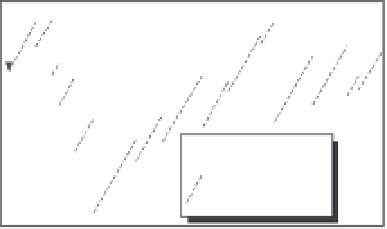Geology Reference
In-Depth Information
With large numbers of events for which the date and amount of slip are known, we can examine
how the slip magnitude varies through time and whether any consistent pattern of rupture behavior
is apparent (see figure E). The short answer is that no clear pattern exists. Large earthquakes can
follow each other, sometimes in close succession, or may have multiple small earthquakes
separating them. Sometimes, interseismic strain accumulation and coseismic strain release are
about equal (from 1500 to 1800AD), whereas for long intervals between 600 and 1500AD, strain
accumulation and release are persistently out of balance. During one such unbalanced interval
(between 690 and 850AD), four large earthquakes occurred and represent an apparent cluster.
Slip Magnitude v Time
Fault Slip Rates
6
50
4
2
2.4 cm/yr
r
2
= 0.94
40
0
30
-2
3.1 cm/yr
r
2
= 0.95
20
-4
-6
Earthquake
Interseismic
slip
8.9 cm/yr
r
2
= 0.99
10
-8
E
F
-10
0
500
750
1000
1250
1500
1750
400
600
800 1000
1200
1400
1600
1800
2000
Calendar Year (AD)
Calendar Year (AD)
E. Slip per event versus time at Wrightwood. F. San Andreas slip rates through time at Wrightwood.
When slip rates are reconstructed in this well-dated site, the data strongly suggest that slip
rates have changed over time (see figure F), such that, for some intervals, slip was more than
three times greater than during others! Such changes in slip rate along a major transform fault
at sub-millennial times are unexpected and not yet well explained. Perhaps most surprising, the
apparent slip rate of 8.9 cm/yr between 690 and 850AD is about twice as fast as the accepted
relative rate between the Pacific Plate and the North American Plate! Because we have no
indications from elsewhere that the relative Pacific-North America rate accelerated during this
interval, let us assume that no such acceleration occurred. We then must consider that, over
multiple earthquake cycles prior to the cluster of large earthquakes, large amounts of
uncompensated elastic strain accumulated in the crust, i.e., each successive earthquake only
partially released the elastic strain that had been built up since the previous earthquake. Given
that the rate of slip (2.4 mm/yr) in the last millennium has been less than the long-term slip rate
of 3.1 mm/yr, “excess” elastic strain may again be present in the crust near Wrightwood, such
that we may be poised for one or several large earthquakes in the near future.
persistent time predictability. These data clearly
imply that major earthquakes should be
expected over the next few decades because
the threshold has been reached that preceded
all of the previous large earthquakes in the past
700 years.
Temporal or spatial clustering
of earthquakes
Within the drumbeat of regular supercycles
along at least part of the Sumatra subduction
zone (Fig. 6.28), temporal clusters of smaller









































































































